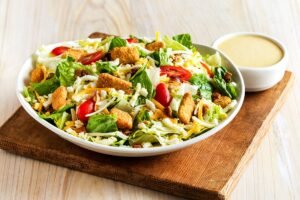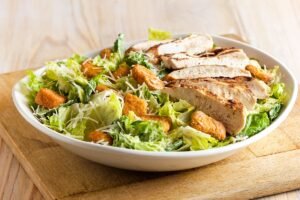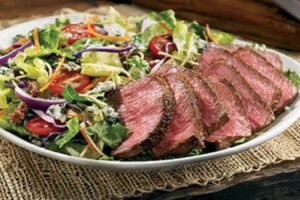Outback’s entrée salads occupy an interesting position on the menu – they’re substantial enough to satisfy but light enough to feel virtuous about ordering at a steakhouse. These aren’t sad desk lunches masquerading as dinner; they’re properly composed salads with serious proteins, house-made dressings, and portions that justify the “entrée” designation.
The salad section serves multiple purposes at Outback. It captures health-conscious diners who still want the steakhouse experience, provides options for those watching their carbohydrate intake, and offers a middle ground between appetizer salads and heavy entrées. With proteins like grilled steak, salmon, and coconut shrimp topping fresh greens, these salads deliver both nutrition and satisfaction.
Fresh Preparation Standards
Every entrée salad starts with greens cut fresh each morning. The lettuce goes through a triple-wash process using water at exactly 38°F to maintain crispness while removing any field debris. After washing, greens spin in commercial dryers for precisely 90 seconds – longer and they bruise, shorter and excess water dilutes dressings.
Mixed greens combine five varieties: romaine for crunch, iceberg for water content, red leaf for color, green leaf for mild flavor, and baby spinach for nutrition. This blend gets mixed in specific ratios (30% romaine, 20% iceberg, 20% red leaf, 20% green leaf, 10% spinach) to create balanced texture and flavor in every bite.
The chopping technique matters more than most realize. Romaine gets cut into 1.5-inch pieces – large enough to maintain structure but small enough for easy eating. Other greens get torn by hand rather than cut, preventing oxidation that turns edges brown. This hand-tearing process takes three times longer than cutting but maintains quality throughout service.
House-Made Dressing Excellence
Outback produces eight different salad dressings in-house, with preparation happening every other day to ensure freshness. The ranch dressing alone requires 14 ingredients, including fresh herbs, buttermilk, and mayonnaise made from scratch. Each batch undergoes taste testing by management before approval for service.
The Caesar dressing recipe took two years to perfect, balancing anchovy paste, garlic, lemon juice, and Parmesan to achieve the right umami depth without overpowering fishiness. The key lies in the emulsification process – ingredients must combine at room temperature using specific mixing speeds to prevent separation.
Blue cheese dressing uses actual Danish blue cheese crumbles, not the processed blue cheese flavor used by many chains. The chunks get folded in after base preparation, maintaining texture variety. Some locations offer “extra chunky” versions for serious blue cheese enthusiasts.
The Oriental ginger-sesame dressing involves reducing fresh ginger juice with rice wine vinegar and sesame oil. This reduction process concentrates flavors while removing harsh ginger bite. The final product contains 30% less sodium than bottled Asian dressings while delivering more complex flavor.
Protein Preparation for Salads
Proteins for entrée salads receive the same attention as standalone entrées. Grilled chicken breasts marinate for 24 hours in a blend of olive oil, citrus juices, and herbs. The marination not only adds flavor but ensures the chicken stays moist when served over cool greens.
Steak for the Steakhouse Salad gets cooked to specified temperature (defaulting to medium-rare unless requested otherwise), then rests for 5 minutes before slicing. The slicing angle – 45 degrees against the grain – ensures tenderness while creating visually appealing presentation. Each slice measures exactly 1/4 inch thick for optimal bite.
Salmon portions for salads are slightly smaller than entrée portions (5 oz. versus 7 oz.) but receive identical preparation. The skin stays on during grilling to prevent sticking, then gets removed before plating. This technique maintains moisture while achieving proper char marks.
Coconut shrimp for salads come from the same batch as appetizers but get special handling. They’re fried to order rather than held under heat lamps, ensuring maximum crispness when hitting the cold salad. The temperature contrast between hot shrimp and cold greens creates textural interest that pre-cooked proteins can’t match.
Seasonal and Regional Variations
Summer months bring expanded salad options featuring seasonal produce. Strawberry fields salad with fresh berries, candied walnuts, and strawberry vinaigrette appears May through July. Watermelon and feta salad shows up in Southern locations during peak watermelon season.
Fall introduces heartier salads like the Harvest Chicken with roasted butternut squash, dried cranberries, and maple vinaigrette. These seasonal options use produce at peak ripeness, often sourced from regional suppliers to reduce transport time and maintain freshness.
Regional preferences influence permanent menu offerings too. California locations feature more avocado-forward salads. Texas restaurants offer a BBQ Ranch Chicken Salad with crispy onions and corn. Florida locations include a Tropical Shrimp Salad with hearts of palm and citrus segments.
Temperature Control and Assembly
The key to great entrée salads lies in temperature contrast – cold, crisp greens with warm proteins. Achieving this requires precise timing and temperature management. Salad bowls get chilled to 35°F before assembly. Greens come directly from refrigeration, never sitting at room temperature.
Hot proteins get cooked to order, timed to finish exactly when the salad base is complete. The assembly happens in under 60 seconds – greens first, then cold toppings arranged in designated sections, hot protein last. This rapid assembly maintains temperature differentials that make salads interesting.
Dressing application follows specific protocols. Side dressing arrives in 2 oz. portions – enough to coat without drowning. When customers request dressed salads, the kitchen uses a specific tossing technique: dressing gets drizzled in a spiral pattern, then the bowl gets tossed exactly 6 times using a lifting motion that coats evenly without bruising greens.
Nutritional Profiles and Modifications
Entrée salads range from 380 calories (Garden Salad with grilled chicken, no dressing) to 1,100 calories (Crispy Chicken Cobb with ranch). The wide range accommodates various dietary goals, from weight loss to muscle building.
Common modifications include protein swaps (grilled for crispy saves 200+ calories), dressing on the side (allows portion control), and cheese deletion (removes 100-150 calories). The kitchen accommodates these requests without pushback, understanding that salad orderers often have specific nutritional goals.
Keto dieters find entrée salads ideal with minor modifications. Removing croutons, crispy noodles, and choosing ranch or blue cheese dressing keeps carbs under 10 grams. Adding extra protein or avocado increases fat content for macro balance.
Gluten-free preparation requires attention to cross-contamination. Dedicated cutting boards, separate crouton storage, and careful protein selection (no breaded items) ensure safety. Most dressings are naturally gluten-free except for Oriental dressing which contains soy sauce.
Value Proposition Analysis
Entrée salads provide interesting value dynamics. The Aussie Cobb at $14.99 contains approximately $8 worth of ingredients, but the labor-intensive assembly and fresh preparation justify pricing. Compared to fast-casual salad chains charging $12-15 for similar offerings, Outback provides larger portions, table service, and complementary bread.
Adding protein to a side salad often costs more than ordering an entrée salad. A Brisbane Caesar ($6.99) plus grilled chicken ($5.99) equals $12.98, while the pre-designed entrée version costs $11.99 with larger portions. This pricing structure rewards ordering entrée salads rather than building your own.
Customer Behavior Patterns
Entrée salad orders follow predictable patterns. Lunch sees 60% of daily salad sales, with the Oriental Chicken and Aussie Cobb leading. Dinner salad orders often come from tables where one person wants steak while another prefers lighter fare.
Women order entrée salads 3.5 times more frequently than men. However, when men do order salads, they typically choose protein-heavy options like the Steakhouse Salad. This gender divide influences portion sizing and protein quantities in recipe development.
Seasonal patterns show salad sales increasing 40% in January (New Year’s resolutions) and declining 25% in November-December (holiday indulgence). These patterns inform inventory management and promotional timing.
Handling Special Requests
Outback’s salad station handles numerous customization requests daily. Common modifications include mixing multiple dressings, adding proteins from other menu items, or creating entirely custom combinations. The kitchen maintains flexibility within reason – they’ll add steak to any salad but won’t create entirely new dressing combinations during service.
Allergies require careful attention with salads due to numerous components. Tree nut allergies mean removing candied pecans and almonds while ensuring no cross-contamination from storage containers. Egg allergies eliminate several dressing options and require Cobb salad modifications.
Servers receive training on guiding salad customization. They learn which modifications work well (adding coconut shrimp to Oriental salad) and which don’t (Caesar dressing on Oriental salad). This guidance helps customers create satisfying combinations while avoiding flavor clashes.
Final Thoughts
Outback’s entrée salads succeed by treating them as seriously as any steak or seafood dish. Fresh ingredients, proper preparation techniques, and generous portions create salads that satisfy rather than disappoint. They’ve managed to make ordering a salad at a steakhouse feel like a smart choice rather than a compromise.
Whether you’re maintaining dietary goals, seeking lighter options in heavy company, or simply craving fresh flavors, these salads deliver. They prove that Outback understands modern dining preferences extend beyond just meat and potatoes, even in a restaurant built on steak reputation.
The entrée salad menu will likely continue expanding as health consciousness grows and dietary preferences diversify. But the core principle remains: execute simple things exceptionally well, and even a salad can become a destination dish worth choosing over a perfectly grilled steak.


